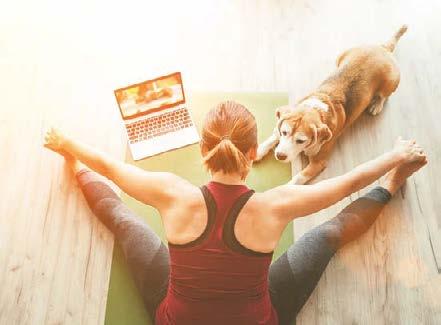
6 minute read
Relieving Menstrual Pain
Relieving Menstrual
Pain
Advertisement
By Natasha Kubis
What is dysmenorrhea?
Dysmenorrhea is a medical term that means “painful periods” and unfortunately 50%-90% of menstruating women experience it every month. It’s ironic that such an important and life-giving biological function can have such an agonizing physical and emotional impact on us. There are a number of ways to decrease menstrual pain and to increase quality of life, allowing for a more amicable monthly visit from Aunt Flo.
What causes menstrual cramping?
Dr. Vicky Scott is the founder of Asheville Gynecology and Wellness, an integrative GYN practice in Asheville, N.C. She is board-certified in obstetrics and gynecology, lifestyle medicine, as well as integrative and holistic medicine. She explains that as women get closer to their period the body starts producing prostaglandins, which are inflammatory compounds that cause the uterus to contract and release its lining. This can cause cramping. Cramps can also occur with an imbalance of estrogen and progesterone, particularly when estrogen levels are too high or progesterone levels are too low.
The following are the most common symptoms of dysmenorrhea:
• Cramping and pain in the lower abdomen • Low back pain • Pain radiating down the legs • Nausea • Vomiting • Diarrhea • Fatigue • Weakness • Fainting • Headaches It is very important to see a gynecologist to address any underlying causes of dysmenorrhea. Other conditions that can cause cramping, pelvic pressure, low back pain, heavy or prolonged periods, and gastrointestinal issues include the following: Endometriosis is a condition that causes the tissue that usually lines your uterus to grow outside the uterus. Polycystic ovary syndrome (PCOS) is a common hormone disorder affecting approximately 1 in 10 women of childbearing age. This is when the body tends to produce higher than normal amounts of male hormones. Symptoms include heavy periods, prolonged periods, excessive facial and body hair, weight gain, trouble losing weight, acne, thinning hair, or hair loss. Fibroids are noncancerous growths that develop inside or outside of the uterus. They range in size from as small as a seed to large masses that can cause an enlarged uterus. The symptoms vary depending on the number of fibroids, their size, and location. Pelvic inflammatory disease (PID) is a bacterial infection of the female reproductive organs. It’s usually caused by sexually transmitted infections, such as chlamydia and gonorrhea. Symptoms include painful intercourse, bleeding during or after sex, foul-smelling vaginal discharge, burning sensation when urinating, fever, and spotting between periods. Adenomyosis is a thickening of the uterus. It occurs when the endometrial tissue that lines your uterus grows into the muscles of your uterus and can cause your uterus to grow two to three times its normal size. An intrauterine device (IUD) is a small birth control device that’s inserted into your uterus. There are different types of IUDs available, some contain-
ing hormones while others are hormone-free. They’re safe for most people, but they can occasionally cause side effects, including severe menstrual cramps, irregular periods, and heavy menstrual bleeding. How to treat painful periods Non-steroidal anti-inflammatory drugs (NSAIDs), such as ibuprofen, help reduce menstrual pain by inhibiting prostaglandin activity, and reducing inflammation. Acetaminophen (Tylenol) is another option if NSAIDS fail to work, or upset the stomach. Hormone therapy such as the birth control pill, skin patches, or a Depo-Provera shot may prevent ovulation and reduce the severity of menstrual cramps. They can also make periods lighter, shorter, and less painful. This is not an option for women who smoke, have a history of blood clots, high blood pressure, or cancer. Regular exercise increases endorphins which can decrease pain. A heating pad across the abdomen can help relax the abdominal muscles. Pelvic floor physical therapy can relieve pelvic floor pain associated with excessive tightening and cramping by helping shortened and contracted muscles to stretch and relax. A hot bath with aromatherapy oils such as lavender, chamomile, and sage can be soothing. Give yourself an abdominal massage by placing your hands over your navel. Begin by making small circles in a clockwise direction. This should be done slowly with moderate pressure for about a minute. Then gradually increase the size of the circling until you are rubbing the entire abdomen.
Food as Medicine
Dr. Scott often recommends proper nutrition and dietary changes to support a healthy and pain free menstrual cycle. Foods eaten can either increase the estrogen effect or reduce it. There have been studies that show that women who eat a high fiber and low fat diet have less estrogen levels and less painful cycles. Here are some dietary and lifestyle recommendations from Dr. Scott: Eat whole grains such as brown rice, whole-grain bread, and oatmeal. Eat vegetables such as broccoli, spinach, carrots, sweet potatoes, Swiss chard, and Brussels sprouts. Eat legumes such as beans, peas, and lentils. Eat fruits such as apples, mangoes, berries, and oranges. Avoid caffeine, alcohol, and tobacco. Avoid refined grains such as white bread, refined cereals, and pastries. Avoid fatty foods such as doughnuts, cheese, French fries, and potato chips. Reduce stress: psychological stress may increase your risk of menstrual cramps. Drink herbal teas such as chamomile, ginger, lemon balm, fenugreek, peppermint, and cramp bark which contain anti-inflammatory and antispasmodic compounds. Supplements such as vitamin E, omega-3 fatty acids, vitamin B-1 (thiamine), vitamin B-6, and magnesium may effectively reduce menstrual cramps.
A Traditional Chinese Medicine Approach
In Chinese medicine, the most common reason for menstrual cramping is because of the stagnation of blood circulation in the lower abdomen. Acupuncture is a safe and effective technique used to increase blood flow, relax contractions, and move stagnation. Researchers at The National Institute of Complementary Medicine at Western Sydney University in Australia conducted a study to compare the efficacy of acupuncture for the treatment of dysmenorrhea. The researchers found that, in all cases, acupuncture led to a significant reduction in the intensity and duration of menstrual pain after three months of treatment.
Yoga as Medicine
Vinita Khatavkar is a seasoned yogi who teaches in the Asheville area. She has been practicing yoga since 1989 and says that regular practice of asanas (yogic postures) and pranayama (breathing techniques) are beneficial for relieving menstrual pain. Every asana can be held for 5 to 6 deep breaths or for a longer duration if it helps with the pain. She notes that inversions such as headstands and shoulder stands, as well as deep twists and backbends, should be avoided while menstruating.
See page 8 for Vinita’s recommended postures for menstrual pain relief

Natasha Kubis is a licensed acupuncturist and certified yoga teacher. For more information, visit
acuwellhealth.com

Supta Baddha Konasana (Reclining Bound Angle Pose)

Upavistha Konasana (Wide Angle Seated Forward Fold) Apanasana (Reclining Knee to Chest Pose)



Malasana (Garland Pose)






